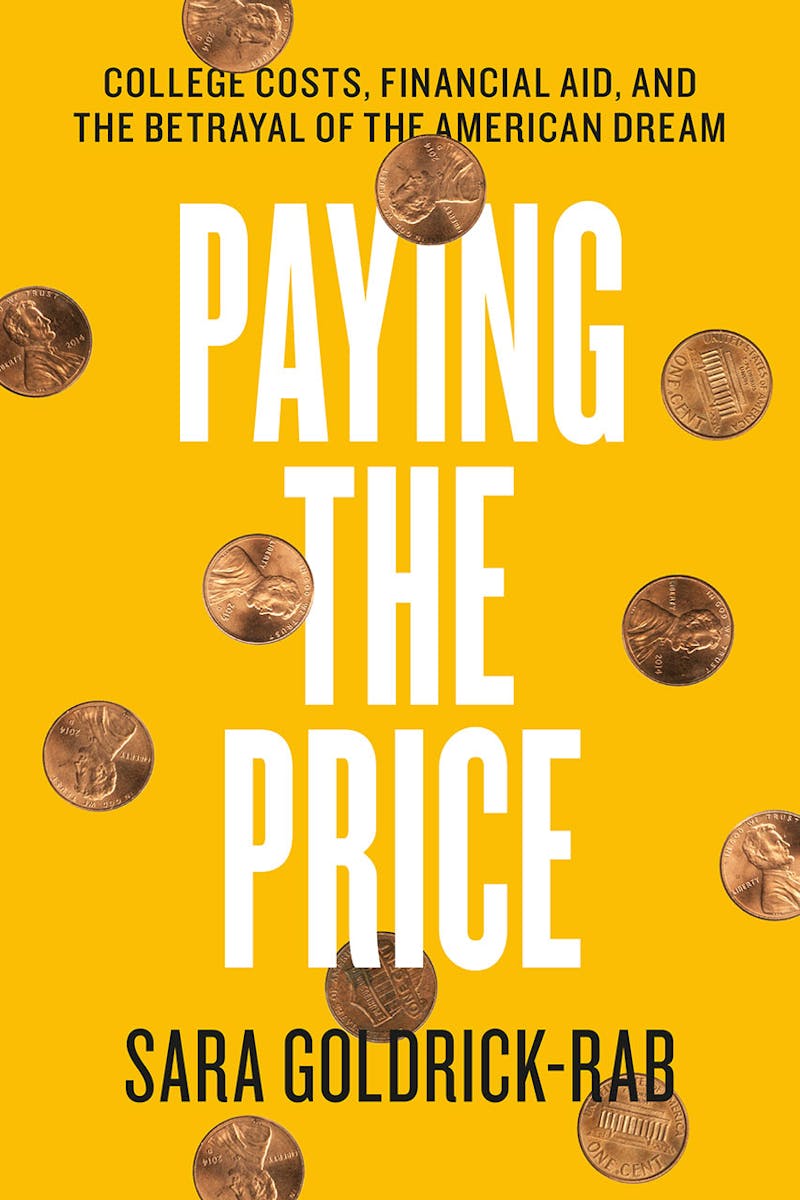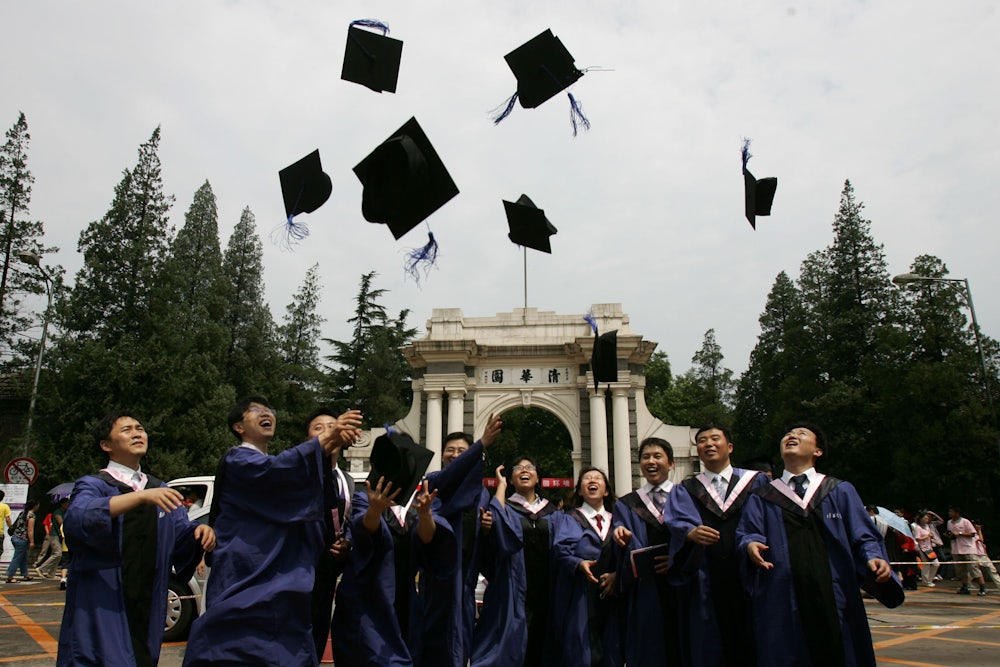The largest college alumni group in the country consists of people who have student debt and no degree. There have always, of course, been more students entering college than graduating, entrants who found freedom or beer or Math 101 too challenging to surmount. But the United States’ massive effort over recent decades to send more low-income students into two- and four-year institutions has not been matched by a realistic understanding of what those students need to succeed, or to survive. The result is wasted time and wasted hopes, and—to move up to a more macro level—a failure to reach national policy goals.

Sara Goldrick-Rab’s important new book, Paying the Price: College Costs, Financial Aid and the Betrayal of the American Dream explains the dire situation, and how badly we need to find a new direction. “Today the promise of a college degree in exchange for hard work dedication no longer holds true,” she declares bluntly. “Instead, students encounter a price so high it has changed what it means to attend college.” It has changed, too, their chances of succeeding when they get there.
Goldrick-Rab explores well-known reasons for the drop in college affordability, and some that are less obvious. She and her researchers at the University of Wisconsin established a data base of 3,000 students entering public colleges and universities with financial aid and followed them for six years, to some happy endings and to too many unhappy ones—and a lot of still unresolved (but generally indebted) outcomes. She focuses on six of these students, using them to illustrate the burdens and traps endangering their efforts to use education to change their lives.
The first sandbag, landing hard on students across the country, has been a rapid state of disinvestment in higher education, leading to a sharp increase in tuition. Goldrick-Rab notes that “a generation ago, public universities received on average about 75 percent of their operating budget from state appropriations. Today that number is closer to 50 percent.” (For many state universities, the number is now far lower. A bitter higher ed observation is that universities have gone from state-supported to state-assisted to state-located.) Over the same period, family incomes have declined for most Americans. States that claim they can’t afford to support their higher education systems have passed the burden to families that can afford it even less. At the same time, costs for living expenses, books, supplies and student fees have been rising even faster than tuition. From 1996 to 2012, for students receiving Pell grants—certified by the federal government as needing help for college—the net price of a year in community college, less grants and federally estimated family contributions, rose from 26 percent of family income to 42 percent.
Goldrick-Rab dissects each element in a low-income student’s financial reality. When Pell grants, the core financial aid program, were launched in the early ’70s, they covered 80 percent of the costs of the average public university and all the costs of a typical community college. “Today, the maximum Pell grant covers less than a third of the cost of attending a public four-year college or university,” she points out, “and barely 60 percent of the cost of attending a community college.”
The pieces expected to fill up that widening gap have their own difficulties. Working your way through college—the fond memory of so many administrators and legislators, causing them to discern a lack of moral fiber in today’s students—is now a tougher mountain to climb, with higher costs on one end and fewer decent-paying jobs at the other. At best, college students end up working more hours a week, which, Goldrick-Rab demonstrates through both statistical patterns and accounts of individual students, is toxic to actual academic success.
Then there’s the “expected family contribution,” perhaps academia’s greatest imaginary number, arrived at after families have slogged through the Free Application for Federal Student Aid (FAFSA). Goldrick-Rab points out that the figure is likely to be higher than realistic for low-income families, and doesn’t account for the financial bumps and setbacks frequent at the low end of the income scale. In fact, she points out, in low-income families, support might be running the other way. Living at home, considered a shrewd money-saving strategy, actually incurs a range of additional other obligations. “Rarely do discussions about the challenges facing college students,” she notes, “recognize the possibility that money might need to flow from the student to the parent or to other relatives—let alone the frequency with which this actually happens.”
Fundamentally, our system doesn’t understand that a low-income student who gets financial aid to attend college does not receive an immediate battlefield promotion to the middle class. She still has the burdens and obligations of being in a low-income family. A system that doesn’t recognize this reality that can set her, and itself, up for failure.
Sometimes, the economic impact is even more direct. Asked to name the biggest challenge of her college life, one student in Goldrick-Rab’s study responded, “Eating.” Studies—including a national survey released last October—show widespread food insecurity among college students, stirring a steady rise of food pantries on campuses. (The book notes that focused efforts to connect eligible students to food stamps and other programs might work even better.) School lunch programs, Goldrick-Rab points out, emerged because of the conclusion that kids can’t learn if they’re hungry; neither can college students.
Paying the Price argues that along with states disinvesting in higher education generally, there are issues on how public money is spent. States tend to appropriate more per student to their flagship research universities than to the urban universities and community colleges that educate less wealthy (and less white) students—which might have something to do with the latter’s lower graduation rates. In her Wisconsin example, in 2012-13 the state gave UW-Madison approximately $12,410 per full-time equivalent student as against $5,157 per FTE at UW-Milwaukee, with a very demographically different student body. A policy aimed at spreading success might distribute the funds differently.
But there is another way to look at this particular issue. Providing wide access to higher education is an important—possibly the most important—role of a state system, but not the only one. Strength of research, supporting the state economy, attracting and retaining a state’s most talented students and helping to shape state policy—a Wisconsin priority within recent memory, if not today—are also vital missions of a system, and qualify for consideration in funding decisions. The same considerations might apply to Goldrick-Rab’s criticism of merit-based financial aid, although its extent could use rethinking.
But the overall financial situation of public higher education is what keeps so many of its entrants from succeeding and is what causes insurmountable student debt to pile up. Much too often, the same student suffers both setbacks. After six years, 38 percent of the 3,000 students Goldrick-Rab was following had left the system without any kind of a degree—47 percent of the community college entrants—and less than 20 percent had achieved a four-year degree. Debt, on the other hand, still followed most of them.
“Time after time,” says Goldrick-Rab, “the failure to complete college does not reflect intellectual inability, but rather an inability to pay.” At Portland State in Oregon, administrators say they worry not only about drop-outs but “stop-outs”—students who leave college intending to earn money to return, but find the path to paying back difficult.
Goldrick-Rab sets out a sweeping goal: “We should follow an incremental approach that begins by making the associate degree free to all who pursue it…Then we can work on making the first degree free at any public college or university.” The United States made high school free and universal, she points out, when it became clear that that level of education was essential to function in society; the same argument could now be made for at least an associate’s degree.
Until then, she proposes a range of possible advances. Connecting federal aid to maintenance-of-effort requirements for states might impede the decades-long state disinvestment in higher education. Students who leave after completing four semesters at a four-year university should qualify for an associate’s degree, even if the universities sniff at giving them out. Giving students and their families more realistic ideas of college costs, and more reasonable expectations of family support, would help.
“The ladder people must climb to get to graduation has eroded, and a critical rung—affordability—is almost completely broken,” concludes Goldrick-Rab. “We have to repair it. Doing nothing will be far more expensive than making an upfront investment now.” There is some reason to think that Goldrick-Rab isn’t simply shouting into the higher education policy wind. Tennessee has set an example with its Tennessee Promise, pledging to use state funds to bolster Pell grants and other funding to cover community college tuition for low-income students. Oregon has now followed Tennessee’s example, and several cities, led by Chicago, are exploring their own versions. These approaches would be useful, although Goldrick-Rab shows convincingly that tuition is only one part of low-income students’ financial problems.
It’s hard to imagine a Trump administration or Republican congressional leaders taking on these challenges nationally; as Goldrick-Rab notes, House Speaker Paul Ryan has described Pell grants as a welfare program. (Curbing the disproportionate amount of debt accrued from for-profit colleges may not appeal to the man who gave Trump University his name.) Even sympathetic state governments may soon to be too swamped by costs of health programs such as Medicaid—a longtime driver of state disinvestment on higher education—to significantly bolster college funding.
The most immediate outcome of her research is not encouraging. After years developing both the Wisconsin Scholars Longitudinal Study and the Wisconsin HOPE Laboratory to study the problem, Goldrick-Rab concluded last spring that the state’s atmosphere under Governor Scott Walker supported neither progress nor realistic assessment, and departed for Temple University in Philadelphia. Like so many of the students she studied, she is now separated from Wisconsin higher education.
